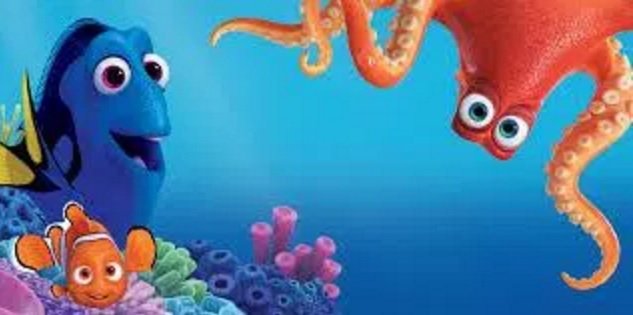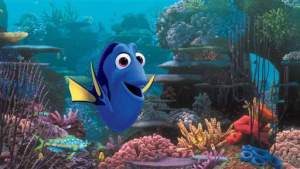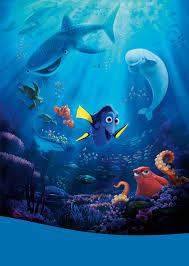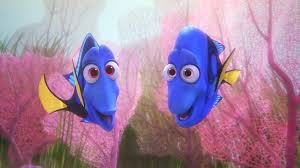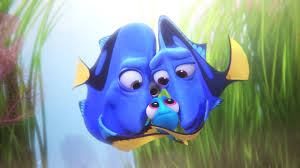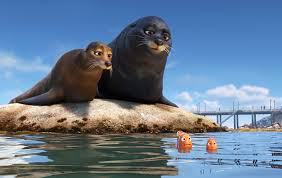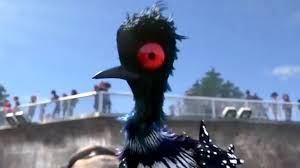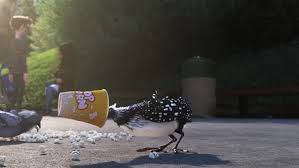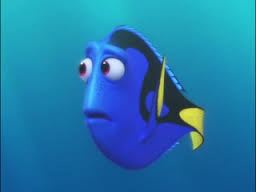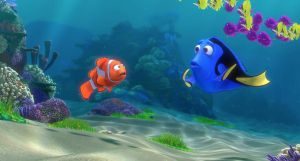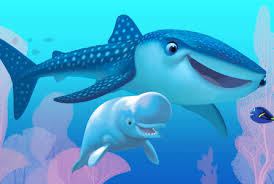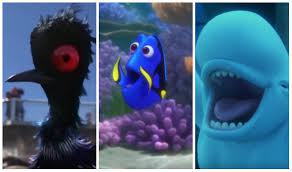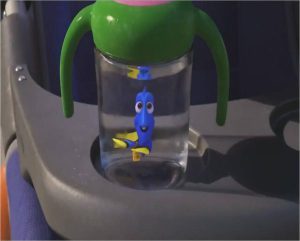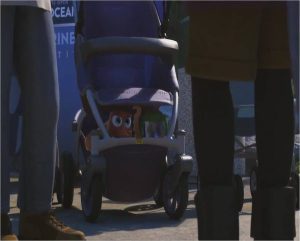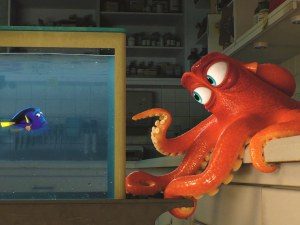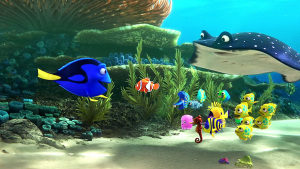Post provided by Alice Wong of the Disability Visibility Project
On June 25th, I saw Finding Dory after reading many positive reviews and recommendations from my disabled friends. I wasn’t disappointed. There was so much to unpack and process when I got home that I decided to write this review/essay.
Finding Dory is film depicts more than disability, it depicts disability culture.*
I tip my crip hat to the artists, writers and directors of this latest gem from Pixar.
Warning: Spoilers to Finding Dory, Finding Nemo and Toy Story 3
People with disabilities do not see themselves very often reflected in popular culture with authenticity steeped in the lived experience. Not only are many disabled characters played bynon-disabled people; the storytellers are usually non-disabled who craft narratives about disability by using stereotypes and cliched tropes, robbing disabled characters and stories of agency and diversity.
Finding Dory has multiple characters with disabilities that live in the community (the ocean) and in institutions (the aquarium, the quarantine section of the aquarium). The characters are part of ecosystems (the coral reef) integrated with non-disabled aquatic creatures. Best yet, Dory, voiced by Ellen Degeneres, is a disabled character that is front-and-center. She is the hero on a journey.
She saves the day not in spite of but because of her disability.
When was the last time a live-action Hollywood film had this type of disability diversity and this many disabled characters interacting with each other?!?
3 ways Finding Dory kept it real about the disability experience
#1: Parental anxiety and support
We see Dory as a young Pacific Regal Blue tang with her parents, Jenny and Charlie, voiced by Diane Keaton and Eugene Levy.
Jenny and Charlie are patient parents who help Dory to be upfront about her disability, encouraging her to practice, “Hi, my name is Dory and I suffer from short-term memory loss.” Not a fan of the term “suffer” but anyhoo…Seeing the group of little tangs swimming nearby, I think Jenny and Charlie were preparing Dory as she planned to venture out to socialize with her peer group. We also see Jenny and Charlie help Dory with her memory by using songs and accommodations such as seashells that enable her to find her way home.
Jenny and Charlie are like many parents of kids with disabilities:
- They worry about her future
- They teach her life skills that she will need
- They are protective about Dory and her safety (“Watch for the undertow!”)
- They show joy and love of Dory being Dory
I got very verklempt near the end of the film when Dory was reunited with her parents. Jenny and Charlie re-constructed their environment with rows of shells radiating from their home in the hopes that Dory will find her way back. When I saw the wide shot of their home and the long rows of seashells like streaming sun beams, I thought about Jenny and Charlie’s dedication and labor. They had every confidence that Dory would find them–they did their best at preparing Dory for the outside world and believed in her abilities. I teared up thinking about my parents and the sacrifices they made for me, such as purchasing a van with a lift (no small feat for a middle class family) and various modifications to our home when I started using an electric wheelchair.
#2: Social Exclusion and Ableism
Pixar kept it real, yo! There are the warm fuzzies and SO many feels that are de rigueur for every. Single. Pixar. Film. The filmmakers balanced the feels with moments of cruelty in Finding Dory in the form of Fluke and Rudder, the two sea lions that Marlin and Nemo encounter during their search for Dory.
Fluke and Rudder (voiced by former cast members from The Wire Iris Elba and Dominic West) are oafish bros who occupy a prime piece of rock real estate near the aquarium. Fluke and Rudder love to sleep and guffaw in a Cockney accent. They help Marlin and Nemo get into the aquarium by calling Becky the loon to transport them via pail of water.
Fluke and Rudder get the pail by luring in Gerald, a non-verbal sea lion who is clearly a sea lion that’s on the fringes of his social group. Gerald looks a bit goofy with his bushy eyebrows and wide-eyed expression and it reinforces his lower status within a larger hierarchy where verbal and physical ability is privileged. Fluke and Rudder bullies Gerald, taking his pail and aggressively pushing him off their rock. They pretend to include Gerald, but then they bray in their loutish sea lion voices, “Off, off, off,” chasing him from their territory.
The treatment of Gerald didn’t go unnoticed. My friend Heather Ure, a “neurodivergent femme-writer-mom” according to her Twitter bio, tweeted:
I took my little ones to see "Finding Dory" this afternoon, & overall, it was a good disability narrative, both for adults & kids. #FilmDis
— Heather Ure (@riotheatherrr) June 20, 2016
& into giving up his sand pail because he lacked "marbles." :/ That was pretty shocking ableism esp. in the context of this movie. #FilmDis
— Heather Ure (@riotheatherrr) June 20, 2016
I relate to Gerald intensely, his wanting to be accepted and being taken advantage of by faux friends/allies. I was angry for Gerald but was delighted to see him in a scene after the credits where he manages to nestle himself on the rock behind Rudder and Fluke and gives a bit of a snicker. He does have agency and is tenacious in getting his place in the sun.
Isn’t that what we all want and deserve at the end of the day, a rock of one’s own and the warmth of the sun?
In another example of ableism, Marlin the clownfish, voiced by Albert Brooks, did a lot of male fishsplaining in Finding Nemo and Finding Dory. Some of it was subtle and came in the form of microaggressions to Dory (when he subtly tried to dissuade Dory from attending Nemo’s field trip because the teacher didn’t want to worry about her safety in case she wandered) and more explicit instances when he blamed Dory for their predicament due to her disability.
When Fluke and Rudder call Becky, Marlin takes one look at her ‘eccentric’ appearance and automatically discounts her abilities. Marlin’s inability to trust the disabled animals in his life and presume competence leads them into more danger. His doubts of Becky and insistence that he knows what to do is called out by Nemo, his son with a disabled fin.
Only after Nemo points out Marlin’s ableism does he flip the script and ‘thinks like Dory’ as a way to find a creative solution. This is a clear celebration of neurodiversity and neurodivergence. Heather Ure tweeted:
knows something about neurodivergence and learning self-care. I was moved and truly surprised to find this in a kids' movie. #FindingDory
— Heather Ure (@riotheatherrr) June 21, 2016
Writer David Chen commented on Finding Dory‘s disability hierarchy in an article where he described both Gerald and Becky:
…it separates animals who are able to speak from those who can’t. The animals who can speak have inner lives, go on adventures, have the ability to help others, possess emotional richness, and generally feel and act like full human beings…Both of these characters feel like cheap jokes. For the kids that are in the audience, they send a pretty clear message: It’s okay to laugh at people who are different, or who aren’t as smart as you are.
To me, this is part of the disability experience of many people: ableism, social exclusion, discrimination, and segregation. You can laugh, celebrate, feel distressed and disturbed, and think critically at the same time. This is what great art does.
I’m glad the filmmakers included those scenes of ableist mistreatment of Gerald and Becky. I cringed during those scenes but I could appreciate the spectrum of the social experience of disabled people. It’s not all happy endings and the struggle is totes real.
There will always be playground bullies and people who underestimate you. Many disabled people know these subtle and not-so-subtle signs when we are not welcome or accepted: the long sighs, the eye-rolls, the sudden change of plans, the concerns about safety or accommodations, the ‘accidental’ exclusion to a party or meeting, etc.
Dory may have memory loss, but she can sense frustration by others as if she’s a burden to them. In fact, she blames herself for losing her parents and apologizes constantly to everyone for simply existing and asking for help (i.e., internalized ableism).
The characterization of Gerald and Becky may result in laughs by some in the audience but this could also serve as an opportunity for adults and children to reflect and wonder, “Why did I laugh when Gerald was pushed in the water? Why is it ok to judge Becky’s abilities based on her looks?”
Pixar films have never shied away from the harsh realities of life. Even with animated films geared for children or featuring young characters, it is a misconception that these films must be positive and idealistic in their storylines and characterization. Think Studio Ghibli films like My Neighbor Totoro and the moments of violence in Finding Nemo (the death of Coral, Nemo’s mother) or heartbreak and rejection in Toy Story 3 (Lotso the bear being replaced and forgotten).
#3: Collective Access
The scene that screamed disability culture to me was the one where Destiny (a whale shark with myopia voiced by Kaitlin Olson), Bailey (a beluga whale with a head injury voiced by Ty Burrell) worked together to provide access for Dory who needed someone to guide her through the pipes to find her parents. Dory communicated her needs. Destiny heard her and relayed them Bailey, encouraging him to attempt echolocation.
Bailey is able to echolocate Dory’s location in the pipe system, relays directions to Destiny, and Destiny speaks to Dory in whale (the language of access through pipes) guiding her all the way with a slight detour into Marlin and Dory.
Patty Berne, Co-Founder and Director of Sins Invalid, described collective access in a June 10, 2015 blog post as one of ten principles of disability justice:
…we value exploring and creating new ways of doing things that go beyond able-bodied/minded normativity. Access needs do not need to be held in shame — we all have various capacities which function differently in various environments…We can share responsibility for our access needs without shame, we can ask our needs be met without compromising our integrity, we can balance autonomy while being in community, we can be unafraid of our vulnerabilities knowing our strengths are respected.
Get a bunch of disabled people together and witness the collective access organically takes place. This isn’t the kind of access mandated by law or provided by an entity or the state. Collective access is community-based and relies on each person’s talents and abilities in a web of interdependence and understanding. It feels good to see people use what they have and share it with others. I love it when I can provide access to a disabled friend in my own small way like typing or reaching for something. And there’s no hesitation or worry about asking my friends for help because they get it, no lengthy explanation or apologies required.
The scenes of collective access in Finding Dory fill me with such pride and solidarity for these disabled animated sea creatures.
Disabled life forms, doing it for themselves. Each in their own way!!
Another two demonstrations of collective access occurs when Hank the septopus (voiced by Ed O’Neill) moves the baby stroller through the aquarium w/ Dory inside a sippy cup.
He’s near the ground navigating while Dory reads the signage and gives him directions.
Dory does the same when they hijack a truck (you have to see it to believe it) and Hank’s tentacles are on the pedals and wheel. Collective access, ya’ll!
Final Random Thoughts
- As a wheelchair user, I laughed out loud when Hank stole the truck and said, “Suck it, bipeds!” This is something I’ve uttered a million times.
- Another major theme is about building families–both chosen families and biological ones.
- Hank reads to me as an someone with trauma in addition to being an amputee since he does not want to be touched.
- It’s nice to see Marlin embrace and respect Dory not out of gratitude (she played a larger role in saving Nemo) but because of who she is by the end of the movie.
- The ending is wonderful when Dory accepts credit for everything she’s accomplished. She is content and comfortable in her own scales.
- Note: I am not exactly sure who voiced the roles of Gerald and Becky. In one wiki, Torbin Xan Bullock is listed the voice of Becky. In imdb.com, the same actor is listed as the voice of Gerald.
Like science fiction and fantasy, animation gives flexibility and space for new ways of telling stories and depicting characters. Perhaps that is one reason why Finding Dory is a massively better movie about disability and disability culture without explicitly being framed as one.
About
Alice Wong is a San Francisco-based disability advocate and Staff Research Associate at the Department of Social and Behavioral Sciences, UCSF. Currently, she is the Founder and Project Coordinator for the Disability Visibility Project (DVP), a community partnership with StoryCorpsand an online community dedicated to recording, amplifying, and sharing disability stories and culture. She is a co-partner with Andrew Pulrang and Gregg Beratan for #CripTheVote, a non-partisan online campaign encouraging the political participation of people with disabilities. You can find her on Twitter: @SFdirewolf and online: DisabilityVisibilityProject.com
*Footnote: Disability culture is described by scholar Steven E. Brown as:
People with disabilities have forged a group identity. We share a common history of oppression and a common bond of resilience. We generate art, music, literature, and other expressions of our lives and our culture, infused from our experience of disability. Most importantly, we are proud of ourselves as people with disabilities. We claim our disabilities with pride as part of our identity. We are who we are: we are people with disabilities.
Other articles/blog posts about Finding Dory
‘Finding Dory,’ Disability, and Me
Elizabeth Picciuto, June 19, 2016, Daily Beast
The One Thing That Bothered Me About ‘Finding Dory’
David Chen, June 19, 2016, SlashFilm.com
‘Finding Dory’ isn’t just about disability — it’s about community and support
Stacia L. Brown, June 24, 2016, The Washington Post
